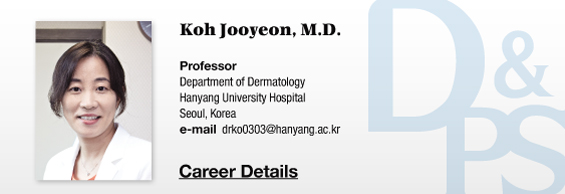
MATERIALS AND METHODS
In this retrospective study, we identified 16 patients with cutaneous vascular disorders who visited the dermatology clinic of Hanyang University Hospital between June 2014 and May 2015. All patients were of Fitzpatrick skin types III and IV. Patients for whom standardized photographs were obtained before and after treatment were considered eligible for inclusion. Patients with a history of deep vein thrombosis, connective tissue disease, predisposition to hypertrophic scars and keloids, oral isotretinoin in the previous 2 months or immunosuppression, or who were pregnant or lactating were excluded.
All patients underwent a single treatment session using a long-pulsed Nd:YAG(Multiflex, Ellipse A/S, Denmark). Surface cooling was achieved using a focused stream of cool air(SoftCool) to reduce pain during treatment and to minimize the risk of possible epidermal damage. To treat vessels with a diameter of 0.2-0.3mm, the following treatment parameters were used: 12.0ms pulse width and 214.2-260.3J/cm2 of fluence using a 1. mm spot. Larger dilated vessels with a diameter of 0.3-0.5mm were treated with a pulse width of 16.0ms and 225.1-252.2 J/cm2 of fluence using a 3.0mm spot. When the vessel was treated with the Laser, the immediate vessel response was carefully tracked. If the vessel disappeared immediately, the next Laser shot was applied at the point where the vanishing point stopped. If the vessel did not show any response after the first shot, the fluence was raised to the next level(10-20J/cm2 higher in general) and the Laser firing point was moved up by about 1-2mm from the initial spot to avoid stacking of Laser pulses.
Clinical assessment was done by two blinded clinicians using Physician Global Assessment(PGA) based on evaluation of pre-treatment photographs and post-treatment photographs taken 1 month after the last treatment. Improvement was assessed on a scale from 0 to 3(0 = no improvement, 1 = moderate, 2 = good, 3 = excellent). In addition, patients were asked to rate their satisfaction with the cosmetic results(1 = not satisfied, 2 = a little satisfied, 3 = somewhat satisfied, 4 = satisfied, 5 = very satisfied). Side effects after treatment were also assessed.
[Advertisement] Reandnè Thread Series – Manufacturer: GTG KOREA(www.gtgkorea.com)
-To be continued




















